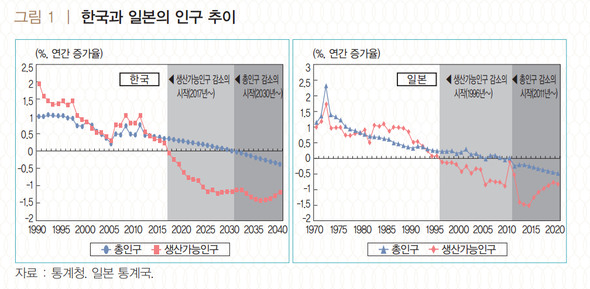hankyoreh
Links to other country sites 다른 나라 사이트 링크
Report: S. Korea could be headed for Japan-style long-term economic downturn

A decline in the productive population and high rates of household debt may leave the South Korean economy suffering a long-term slump like Japan’s, according to a report by a state-run think tank.
The report, titled “Examining the Possibility of a Japanese-Style Long-Term Downturn for the South Korean Economy,” was published on Apr. 13 by Kang Doo-yong, a senior researcher at the Korea Institute for Industrial Economics and Trade (KIET). Kang notes that similar changes in population and economic structure between South Korea and Japan mean the former could be in for the same kind of protracted slump the latter has experienced over past decades.

The biggest risk factor cited in the study was a decline in the productive population. Noting a lag of roughly 20 years in population trends between Japan and South Korea, Kang predicted the South Korean productive population could enter a decline as soon as 2016 or 2017, with a similar trend for the general population around 2030.
Japan’s declines in the productive and general populations began in 1996 and 2011, respectively.
Kang also predicted South Korea’s economic growth rate would fall below 3% in the late 2010s and below 2% after 2020 once the productive population begins its decline.
Household debt was another risk factor cited as contributing to the possibility of a long-term downturn for the South Korean economy. In particular, the report notes that skyrocketing household debt has left the country with a ratio to disposal income far beyond the high recorded in the US prior to its financial crisis.
The growing burden of principal repayments is also shaping into a severe hindrance on consumption, Kang observed.
The report also found South Korea unlikely to sustain its past high rate of increase in exports, long the chief drivers of its economic growth. The average yearly rate of increase for exports plummeted from 11.9% in the pre-crisis years of 2000-08 to just 1% between 2011 and 2014.
“Support for household income generation should be coupled with efforts to encourage smooth debt adjustment, and a proactive response is needed for the low birth rate and aging trend issues, which have a crucial effect on the encouragement of domestic demand and long-term growth,” Kang said.
By Song Kyung-hwa, staff reporter
Please direct questions or comments to [english@hani.co.kr]

Editorial・opinion
![[Column] Park Geun-hye déjà vu in Yoon Suk-yeol [Column] Park Geun-hye déjà vu in Yoon Suk-yeol](https://flexible.img.hani.co.kr/flexible/normal/500/300/imgdb/original/2024/0424/651713945113788.jpg) [Column] Park Geun-hye déjà vu in Yoon Suk-yeol
[Column] Park Geun-hye déjà vu in Yoon Suk-yeol![[Editorial] New weight of N. Korea’s nuclear threats makes dialogue all the more urgent [Editorial] New weight of N. Korea’s nuclear threats makes dialogue all the more urgent](https://flexible.img.hani.co.kr/flexible/normal/500/300/imgdb/original/2024/0424/7317139454662664.jpg) [Editorial] New weight of N. Korea’s nuclear threats makes dialogue all the more urgent
[Editorial] New weight of N. Korea’s nuclear threats makes dialogue all the more urgent- [Guest essay] The real reason Korea’s new right wants to dub Rhee a founding father
- [Column] ‘Choson’: Is it time we start referring to N. Korea in its own terms?
- [Editorial] Japan’s rewriting of history with Korea has gone too far
- [Column] The president’s questionable capacity for dialogue
- [Column] Are chaebol firms just pizza pies for families to divvy up as they please?
- [Column] Has Korea, too, crossed the Rubicon on China?
- [Correspondent’s column] In Japan’s alliance with US, echoes of its past alliances with UK
- [Editorial] Does Yoon think the Korean public is wrong?
Most viewed articles
- 1‘We must say no’: Seoul defense chief on Korean, USFK involvement in hypothetical Taiwan crisis
- 2N. Korean delegation’s trip to Iran shows how Pyongyang is leveraging ties with Moscow
- 3Amnesty notes ‘erosion’ of freedom of expression in Korea in annual human rights report
- 4[Column] Park Geun-hye déjà vu in Yoon Suk-yeol
- 5‘Weddingflation’ breaks the bank for Korean couples-to-be
- 6[Reportage] On US campuses, student risk arrest as they call for divestment from Israel
- 7[Editorial] New weight of N. Korea’s nuclear threats makes dialogue all the more urgent
- 8Why Korea shouldn’t welcome Japan’s newly beefed up defense cooperation with US
- 9[Guest essay] The real reason Korea’s new right wants to dub Rhee a founding father
- 10Will NewJeans end up collateral damage in internal feud at K-pop juggernaut Hybe?